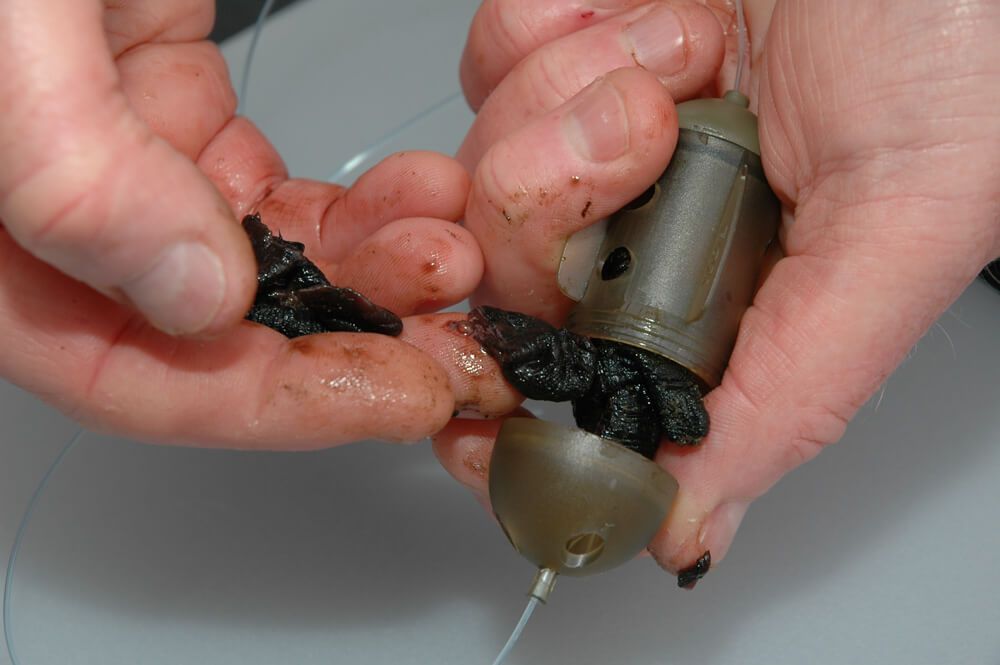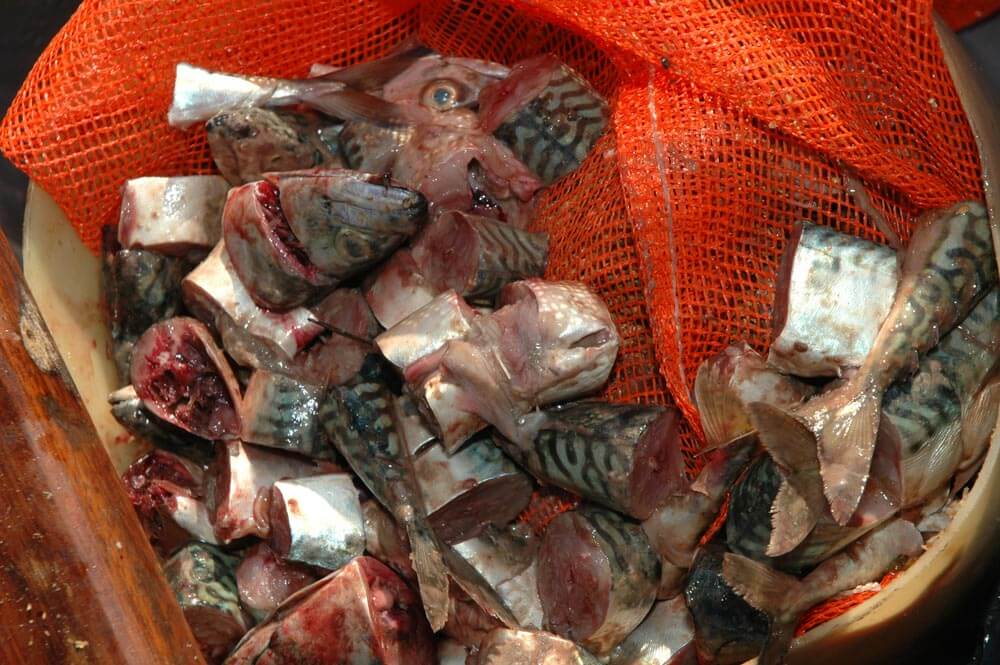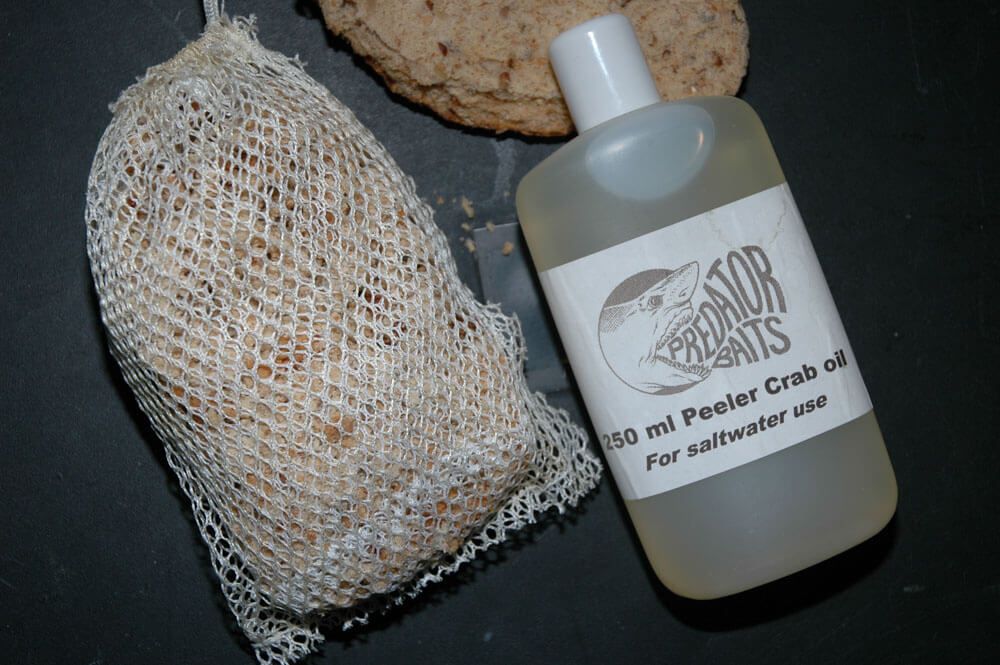The use of ground bait, mullet fishing aside, in sea fishing is minimal, yet the majority of sea species will be drawn to an area where bait is concentrated just the same as occurs in freshwater. The big advantage in the sea though, is that you invariably always have some tide running to help distribute the scent and draw fish in from a wide area.
Match and free thinking freelance anglers are in the habit of saving all the old bits of bait they remove from their hooks when re baiting. After each new cast it’s worth the short walk to the sea edge and just throwing the used bits of bait out in to the surf tables. Some of the bait bits wash ashore, but others will be drawn out by the drag of the waves distributing bits of bait and dispersing their scent across a wide area. Do this for a few casts and the amount of bait builds up creating a ground bait effect that will draw in flounder, school bass, pout, rockling, dogfish and other small species. This is a great way to gain extra fish during calm weather when catches can be subdued and is a top tactic using a second rod casting close in.
To maximise the effectiveness of ground bait you need to copy our freshwater colleagues and adopt swim feeders in to your rig.
Feeders work just as well in saltwater as they do in freshwater and are universally effective for close to medium range fishing over sand. Used over plain featureless sand the increased scent they put out obviously draws individual fish scattered over a wide area in towards the main bait and gives you a big edge when bites and fish are scarce. This applies particularly to the scratching season from February through to mid April.

Feeders work best though, if the angler can identify main beach features such as gutters, gullies, sandbanks, small patches of weed or rock. These will hold fish as they move in and out with the tide. Accurate casting to put the feeder just uptide of the feature to make the most use of the tide run to filter the scent and food bits downtide in to the feature makes a casual passing audience a captive one. By accurately recasting the feeder each time you can literally build up a “swim” just as you would in freshwater. This is especially effective for flounder, whiting, rays, dogfish and dabs fishing in to gullies and depressions where food naturally collects.
Feeders are a good choice in estuaries for the same reason. Strategic casting putting the feeder and bait on the inside edges of main bends in the estuary channel or side creeks where flounder typically lay makes good use of the tide current and distributes scent way down stream. This is great spring and summer tactic for eels too.
Boat anglers can also get better results incorporating a feeder in to a rig. Adding a feeder just above the lead to a two-hook black bream rig will produce far more bites, especially if you’re fishing alongside other anglers at the stern of the boat. Bream, being a shoal fish, are competing hard for any available food. They instinctively go for the area where the scent is strongest. By presenting your baits above a feeder you are drawing the bulk of the fish directly to your own baits, and the biggest fish tend to be the most competitive in a tight shoal and will bully smaller fish away from a small area where food is concentrated. The same tactic works well over sand banks for whiting and dabs.
The use of a feeder on an uptide rig can catch you far more rays than any bait fished individually. Rays respond to a sudden strong scent trail and are willing to move to follow it up providing the scent trail stays consistent. This is where standard baits without the benefit of a feeder fall down, the bait washes out too quickly leaving a week scent trail that a ray some way off may not feel is worth pursuing. The feeder helps compensate for the rapid wash out of a hook bait by slowly releasing scent in to the water retaining a stronger overall scent for the ray to follow up. It would surprise some anglers just how far fish will travel up a scent trail to find a bait if the strength of bait remains strong enough.

If you’re at anchor in shallow water, occasionally dropping small chunks of fish and old bait in to the tide can draw fish in from hundreds of yards behind the boat. Even these small bits of bait will eventually reach the seabed through gravity. This tactic works in conjunction with your hooks baits to create a long consistent scent trail.
Sharks respond well to the same tactic, which is used to draw deep swimming shark higher up in the water table and in to the scent trail released by the chum sacks.
Reef bass in particular respond very well to small bags of broken up hardback crabs hung off the back of the boat to filter down with the tide when anchored just uptide of the reef and dropping crab baits back.
GROUND BAIT TYPES AND MIXES
For a fine quick release mixture for close range fishing for flounder and eels use dry white bread crumb mixed with finely chopped bits of worm or crab. Aim for a soft but semi dry consistency that will stay in the feeder for casting, but break up gently through tide action.

For oily baits like mackerel when targeting bream, rays and huss, then use a fine animal feed bran. This soaks up the oil better than bread and is coarse enough to stay in the feeder for longer range casting.
If you want an explosion of scent from a single bait type, then simply pack the feeder with old bits of hook bait topped up with chunks of fresh. This works best with black lug, mackerel, herring, sandeel, and soft or peeler crab.
Fish based cat food is also a good general feeder filler when mixed with a little bread crumb and bran to stiffen it up. Cat food seems especially effective for pulling in dogfish and eels inside estuaries. A good one is Felix in salmon and prawn flavour.
PRESENTATION
The best feeders are the in line type. These can be rigged to fish tight behind the lead for casting. They are ideal rigged as a sliding ledger rig with the main hook trace mounted below the lead which is attached to a sliding link on the main rig and fished hard on the seabed in the middle of the scent trail when close range casting in to surf, or when estuary fishing.
For longer range casting to specific seabed feature, then rig the feeder fixed in place tight behind the lead again, but have the hook above the feeder positioned as a conventional paternoster.
A good way to rig an in line feeder for sea fishing is to use a rubber buffer bead to protect the knot on the lead link, and another rubber bead for the feeder to butt up against. Lock the feeder in place, leaving enough room for the feeder to be loaded, using a crimp and bead positioned above the feeder on the main rig body line.
For very close range work with minimal tide run, then a standard feeder used without a conventional lead weight below with the hook trace rigged paternoster style will be enough to hold on the seabed. You can use a three-way swivel for easy rigging with the hook trace on the middle eye and the feeder tied to the lower eye on a short 18-inch length of line.
TIPS
When using bran, you may need to open up the holes in the feeder with a knife or scissors to allow the bran to release more freely. Bigger holes can also be used to give a faster release of bait when building up a feeding area.
When building a feeder rig, aim to have one hook fishing close to the feeder. Fish are drawn to the strongest scent and are most likely to take the bait nearest to the feeder.
Match and free thinking freelance anglers are in the habit of saving all the old bits of bait they remove from their hooks when re baiting. After each new cast it’s worth the short walk to the sea edge and just throwing the used bits of bait out in to the surf tables. Some of the bait bits wash ashore, but others will be drawn out by the drag of the waves distributing bits of bait and dispersing their scent across a wide area. Do this for a few casts and the amount of bait builds up creating a ground bait effect that will draw in flounder, school bass, pout, rockling, dogfish and other small species. This is a great way to gain extra fish during calm weather when catches can be subdued and is a top tactic using a second rod casting close in.
To maximise the effectiveness of ground bait you need to copy our freshwater colleagues and adopt swim feeders in to your rig.
Feeders work just as well in saltwater as they do in freshwater and are universally effective for close to medium range fishing over sand. Used over plain featureless sand the increased scent they put out obviously draws individual fish scattered over a wide area in towards the main bait and gives you a big edge when bites and fish are scarce. This applies particularly to the scratching season from February through to mid April.

Feeders work best though, if the angler can identify main beach features such as gutters, gullies, sandbanks, small patches of weed or rock. These will hold fish as they move in and out with the tide. Accurate casting to put the feeder just uptide of the feature to make the most use of the tide run to filter the scent and food bits downtide in to the feature makes a casual passing audience a captive one. By accurately recasting the feeder each time you can literally build up a “swim” just as you would in freshwater. This is especially effective for flounder, whiting, rays, dogfish and dabs fishing in to gullies and depressions where food naturally collects.
Feeders are a good choice in estuaries for the same reason. Strategic casting putting the feeder and bait on the inside edges of main bends in the estuary channel or side creeks where flounder typically lay makes good use of the tide current and distributes scent way down stream. This is great spring and summer tactic for eels too.
Boat anglers can also get better results incorporating a feeder in to a rig. Adding a feeder just above the lead to a two-hook black bream rig will produce far more bites, especially if you’re fishing alongside other anglers at the stern of the boat. Bream, being a shoal fish, are competing hard for any available food. They instinctively go for the area where the scent is strongest. By presenting your baits above a feeder you are drawing the bulk of the fish directly to your own baits, and the biggest fish tend to be the most competitive in a tight shoal and will bully smaller fish away from a small area where food is concentrated. The same tactic works well over sand banks for whiting and dabs.
The use of a feeder on an uptide rig can catch you far more rays than any bait fished individually. Rays respond to a sudden strong scent trail and are willing to move to follow it up providing the scent trail stays consistent. This is where standard baits without the benefit of a feeder fall down, the bait washes out too quickly leaving a week scent trail that a ray some way off may not feel is worth pursuing. The feeder helps compensate for the rapid wash out of a hook bait by slowly releasing scent in to the water retaining a stronger overall scent for the ray to follow up. It would surprise some anglers just how far fish will travel up a scent trail to find a bait if the strength of bait remains strong enough.

If you’re at anchor in shallow water, occasionally dropping small chunks of fish and old bait in to the tide can draw fish in from hundreds of yards behind the boat. Even these small bits of bait will eventually reach the seabed through gravity. This tactic works in conjunction with your hooks baits to create a long consistent scent trail.
Sharks respond well to the same tactic, which is used to draw deep swimming shark higher up in the water table and in to the scent trail released by the chum sacks.
Reef bass in particular respond very well to small bags of broken up hardback crabs hung off the back of the boat to filter down with the tide when anchored just uptide of the reef and dropping crab baits back.
GROUND BAIT TYPES AND MIXES
For a fine quick release mixture for close range fishing for flounder and eels use dry white bread crumb mixed with finely chopped bits of worm or crab. Aim for a soft but semi dry consistency that will stay in the feeder for casting, but break up gently through tide action.

For oily baits like mackerel when targeting bream, rays and huss, then use a fine animal feed bran. This soaks up the oil better than bread and is coarse enough to stay in the feeder for longer range casting.
If you want an explosion of scent from a single bait type, then simply pack the feeder with old bits of hook bait topped up with chunks of fresh. This works best with black lug, mackerel, herring, sandeel, and soft or peeler crab.
Fish based cat food is also a good general feeder filler when mixed with a little bread crumb and bran to stiffen it up. Cat food seems especially effective for pulling in dogfish and eels inside estuaries. A good one is Felix in salmon and prawn flavour.
PRESENTATION
The best feeders are the in line type. These can be rigged to fish tight behind the lead for casting. They are ideal rigged as a sliding ledger rig with the main hook trace mounted below the lead which is attached to a sliding link on the main rig and fished hard on the seabed in the middle of the scent trail when close range casting in to surf, or when estuary fishing.
For longer range casting to specific seabed feature, then rig the feeder fixed in place tight behind the lead again, but have the hook above the feeder positioned as a conventional paternoster.
A good way to rig an in line feeder for sea fishing is to use a rubber buffer bead to protect the knot on the lead link, and another rubber bead for the feeder to butt up against. Lock the feeder in place, leaving enough room for the feeder to be loaded, using a crimp and bead positioned above the feeder on the main rig body line.
For very close range work with minimal tide run, then a standard feeder used without a conventional lead weight below with the hook trace rigged paternoster style will be enough to hold on the seabed. You can use a three-way swivel for easy rigging with the hook trace on the middle eye and the feeder tied to the lower eye on a short 18-inch length of line.
TIPS
When using bran, you may need to open up the holes in the feeder with a knife or scissors to allow the bran to release more freely. Bigger holes can also be used to give a faster release of bait when building up a feeding area.
When building a feeder rig, aim to have one hook fishing close to the feeder. Fish are drawn to the strongest scent and are most likely to take the bait nearest to the feeder.

